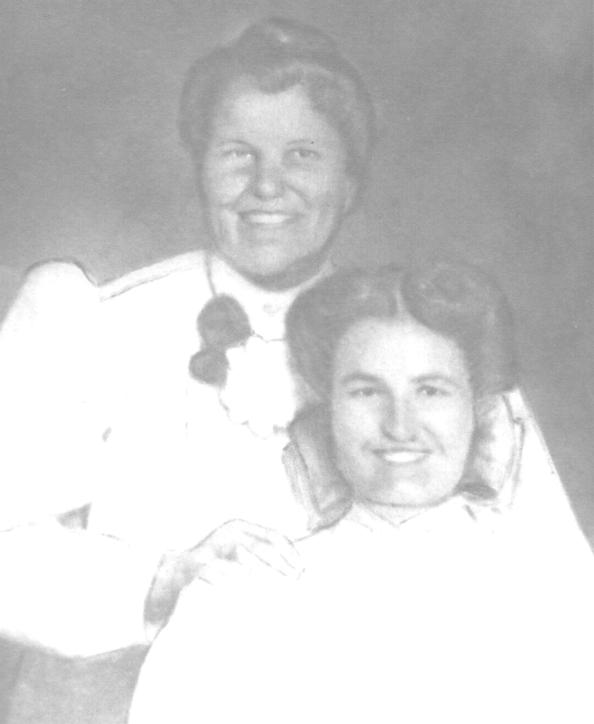SONS OF DEWITT COLONY TEXAS
1586-1950 From Flanders Fields & Nottinghamshire to Manhattan, Staten Island & West Jersey to North Carolina to Mississippi to Arkansas & Texas by Wallace C. & Wallace L. McKeehan
JOSEPHINE
MOORE MCKEEHAN Born 29 Apr. 1882 in Ozark, Franklin County, Arkansas Married James Washington McKeehan in 1900 in Miller County, Arkansas Died 9 Nov. 1950 in Cass County, Texas The Children | Odyssey of the Moore Family
Supported by her faith in God, Josephine Moore McKeehan gave birth to 13 healthy children between age 19 and 40 and raised them all to adulthood a family of 13 children over a period of 40 years. In addition, she raised two grandchildren, Neil and Henrietta (Boots) Phillips (children of Seth and Glenn Marie McKeehan Phillips). Doctors in the period were few and far between and in some cases were beyond the means of simple families to pay. Rugged women like Josephine Moore McKeehan of necessity learned how to perform health care duties. Her skills saved her son (WCM), an author of this article, when a boy of twelve from death from pneumonia. To her credit is the fact that two of her sons were called to the ministry which resulted in many souls turning to God. Josephine Moore, together with James Washington, gave to their children, not only the basic needs, but set the examples and passed on the values that stayed with each throughout their long lives. The last of the 13 children passed on in 2014 at age 96. The average age at death was 87 years, males 86 and females 89. All children were healthy from birth, never deprived of basic needs supported by the agricultural life on the land and all grew into adulthood without benefit of gas, electricity or running water. Josephine Moore McKeehan passed away at the age of 68 due to diabetes, a disease that is now manageable or even curable. The descendants cannot say thanks enough, but keep her memory alive by visiting her resting place in Old Harmony Grove Cemetery, Miller County, Arkansas. Her memory and that of husband James Washington has been kept alive in a memorial family reunion over the years. Josephine Moore was the daughter of James Morgan Moore (b. MS 1849-1925) and Nancy Priscilla Touchstone (b. MS 1851-1934) who were married in Shubuta, Clarke County, MS. James M. Moore was the son of Charles L. Moore (b. 1820 in SC) and Elizabeth F. (b. 1815 in MS). Considerable research has been done on the Touchstone Family and can be obtained by contacting: Samuel Touchstone, Folk-Life Books, PO Box 128, Princeton, LA 71067. Nancy Priscilla Touchstone was the daughter of Jesse Jackson Touchstone (b. MS 1823-1860) and Mary Elizabeth (Poly) Merrell Touchstone (b. MS 1826-1894). Mary Elizabeth Merrell was the daughter of Abel Merrell (b. SC 1800-1866) and Eliza Cooley (b. SC 1804-1873). Abel Merrell was a grandson of well-known patriot Capt. Benjamin Merrell of North Carolina. Eliza Cooley Merrell was a daughter of William Cooley (ca. 1780-1850), son of John Cooley (ca. 1745-1795). The history of the Cooley family of South Carolina has also been extensively researched. The antecedants of Capt. Merrell and his wife Jemimah Smith have also been extensively researched. They include the Merrill, Du Trieux/Truax, Marchand/Mershon, Stout and Andrew Smith families involved in the settlement of Staten, Manhattan and Long Island and East and West New Jersey.
by daughter Mabel Clara McKeehan Wise (b. 1910) [The following is a verbatim reproduction of a manuscript written April 13, l982. Mabel Clara McKeehan, also known as Gib, was the seventh child of James Washington and Josephine Moore McKeehan, born July 9, 1910 in Miller County, Arkansas. She died July 13, 2001 just after her 91st birthday. Bracketed passages are the editor’s] The life and testimony of Mrs. Josephine McKeehan is a beautiful story to remember by those who knew her and a blessing to many of the Lord’s children. In Romans 12:1, it is written "I beseech you brethren, by the mercies of God, that you present your bodies a living sacrifice, holy acceptable unto God, which is your reasonable service." This was the uppermost trait in the life of Mother McKeehan, the presenting of herself in service of God, her fellowman and to her family. Josephine was the wife of James W. McKeehan, who was a prominant member of the Old Mt. Pleasant Church, a country community near Texarkana, Arkansas and Texas. Mr. McKeehan served many years as the Sunday School Superintendant. We worshipped then in the school house. There I remember the Sisters shouting so much their hair would fall down their backs. That was the Methodist people of yester years. Today they have a nice brick church and the name has been changed to Few Memorial Methodist Church. Mr. Few was a member of the church and served along with Mr. McKeehan. In later years he became prosperous and donated the money to build the new church. The new church being named in honor of Mr. Few.
James and Josephine [Moore McKeehan] were joined together in marriage and to this union were born thirteen children. Five boys and eight girls plus they raised two grandchildren [Neil and Henrietta (Boots) Phillips, children of Glenn Marie McKeehan and Seth Phillips]. Today, April 13, 1982, all of these children are still living except the grandson [Neil Phillips] who was killed in an accident at the age of 24. They were all healthy normal children. There was lots of fun, fighting and feuding. Yet today, these children are a closely knit family. We give all the glory to Jesus as an answer to the prayers of this faithful saint [Josephine Moore] of God. Mother McKeehan was held in high esteem in the community in which she lived and there were several of them [communities]. So many times she was called upon to render aid to the sick and to help the country town doctors deliver babies that were born to the farmers in the community. On one occasion my sister, Florence [Henrietta Florence McKeehan Lee (1908-1992], and I went with our mother, it being in the middle of the night. The neighbor was in labor and the baby, a tiny girl, was born dead. My sister and I were just teenagers, but Mother McKeehan was tied up helping the Dr. with the new mother and we were given the job of bathing and dressing the infant for burial. I shall never forget the occasion. We argued about who would touch it first and decided we would both touch it at the same time. After that we had no problem. When we got through [with the preparation for burial], it looked like a beautiful little doll. Mother McKeehan suffered lots of hardship and trials and work to get her children through school. Our father [James Washington] was called to preach when he was a young man and he told God he did not have enough education to preach the Gospel. So his life was spent running from God. He kept us poor moving so much. Through all this, Mother McKeehan kept her faith in God and one of her favorite scriptures was Job 13:15. We were very poor, but God always provided. Mother always had time in the evenings for some Bible reading. In the summertime, Mother McKeehan went to a plum thicket to pray. This was out back of the peach orchard and it was there that mother had an altar to pray alone. I can see her yet headed to the thicket after the evening meal. The older girls did the dishes. Just think a little of the work, just to do the laundry without any modern conveniences. The girls were a lot of help to the mother while the boys did the field work as they became large enough. Then the children began to reach adulthood, marry and were scattered. But not ever so far away.
Nine years prior to her death, she [Josephine Moore McKeehan] developed diabetes. Due to an old shoe she was wearing around the house, she rubbed a blister on her toe. Her husband was in bed with pneumonia and while caring for him, she was careless about taking care of the toe. Not being aware that she had diabetes, this toe got bad. Somehow, the Lord sent the youngest son’s [John Braxton McKeehan, b. 1922] wife [Betty Hughes McKeehan] to visit, her husband being overseas in the Air Force. The daughter-in-law was an RN [Registered Nurse] and quickly detected something was wrong. She unwrapped the toe, then exclaimed a bad word. She said "mom, I must get you to a Dr. and that in a hurry." But it was too late to save the foot. Gangrene had already set in and Mother McKeehan lost the leg just below the knee. The poor dear woman was so weak that she could not use a crutch so the remainder of her life her waking hours were spent in a wheel chair. She kept up the cooking and dishes, but the girls who lived near did the laundry. Through all this, she never complained, always keeping faith in her God. At the last, near the end [November 1950], the children were all called in. All thirteen were there except one son. The little Assembly of God minister and wife, who stood by them so faithful, were there too. In the wee hours of the morning [November 9, 1950], we all watched the doctor as he held her pulse waiting for the end. The room filled with a blue heavenly haze. We all saw it and we all saw tears roll down the doctor’s cheeks. Then he said "Children, this is it, she is gone. She was the best patient that I have ever doctored. With all that she has been through these past nine years, I have never heard her complain. Not even when I amputated her leg." Mrs. Patterson [Ruble Bradeen McKeehan Patterson (b. 1915)], the daughter who lived so close and gave her the insulin each day bowed her head to cry. Instead she broke forth speaking in a heavenly language (by the Holy Ghost) and the blue haze faded away. It was then that we knew that the angels had come and born our dear mother away. She was laid to rest just a few miles out of Texarkana, Arkansas. Today the memory of this true soldier of the Cross lives in the hearts of her children. Once each year, the fourth Sunday in June, all these children and their children meet at Spring Lake Park in Texarkana for a family reunion in memory of this couple who worked so hard to get us all grown and educated. And what a time we have, eating the good food brought in by the members of the family and sharing some of the good memories of by-gone years. And we pray that God will extend His mercy to spare us all to meet this year as usual. It is my prayer that this testimony will be a blessing to whomsoever may read it. There is so much that could be added but this is some of the highlights. I am the middle one [signed] Mabel C. Wise. The Odyssey
of James Morgan Moore (1849-1925) Children of James M. and Nancy Priscilla Moore Early Days in Mississippi The Charles L. Moore Farm, Jasper County, Mississippi. A few years before the Civil War on the farm/ranch of Charles L. and Elizabeth Moore in Jasper County, Mississippi, Jim Moore was the fourth of seven known children born on the farm. Until his 19th birthday, Jim learned and applied the skills that would prove to be very important and useful in the personal odyssey described herein. It is unclear if Charles L. Moore and family owned slaves to help tend the entire section of land they occupied (no slaves are listed with household in censuses). The normal life style of the times was work, work and more work. Cotton was King and most farms dedicated a large percentage of their acreage to cotton production. Too young to serve in the Civil War (1861-1865), Jim performed the tasks of a full grown man at home on the Moore farm while learning the skills which he would find necessary to make a living during his future wanderings. He learned how to tend stock, how to plow the fields, how to swing an ax, how to pull a crosscut saw. He learned how to clear land, cultivate it, raise stock on it and to keep the year round supply of wood fuel for cooking and heating in the winter. From his father Charles L. Moore, he learned how to make horseshoes and to put them on a horse. Jim learned how to use the bow and arrow from the friendly Indians in the area. He learned from his father how to shoot wild turkey and other game. In the few free moments between concentrated work and while simply tending stock, a dream and restlessness was stirring in his mind. To himself, he asked what horse or mule or what man could keep on going like this day after day, month after month, year after year? He dreamed of worlds away and experiences and places far beyond the Jasper County farm. In those days and at his age, a world away was the next county and thus began the odyssey and wandering of James Morgan Moore. Love and Romance in Clarke County. In his 19th year (1868), Jim wandered over into the adjoining county of Clarke in Mississippi. There he encountered the Jesse Jackson Touchstone family among whom was the beautiful Nancy Priscilla Touchstone. The shy 17 year old Nancy wondered, "Who is this strong, blue-eyed, fair-skinned foreign stranger from Jasper County? What is he up to?" Jim’s experience on the Moore homestead and surroundings in Jasper County made it easy to find work for support and he remained in residence near the Touchstone family in Clarke County as his first independent life. He was known for the one song he sang while working and while wandering along from field to home "A Counting I Go." Soon after his arrival, with the blessings of both the Moore and Touchstone families, Jim and Priscilla were married in Shubuta, Clarke County, Mississippi prior to 1871. Ten years passed and five children were born before Nancy Priscilla’s modest dowry was passed to the family largely accumulated by efforts of the Cooley, Merrell and Touchstone families. The Civil War and Urge to Go West. The devastation and hardship brought to Mississippi which was on the losing side after the Civil War caused considerable anxiety to the family. In addition to it becoming harder to make a living on the family farms, turmoil and rumor abounded, both bad and good. The country was active with strangers--carpetbaggers from the North and traders from all parts of the country. Among those were travelers from the West speaking of a paradise far different from the devastation they saw in Mississippi. They told of forests and trees abundant with nuts and wild fruits, wild berries in season, an abundance of wild game on which one could survive while searching for a homestead on which to settle and make a steady living. They spoke of unlimited lands and forests waiting for development by the common man. There were also frightful stories of robbers, bandits and renegade Indians that refused to participate in the government relocation programs. There were stories of the wild animals and poisonous snakes in the lowlands and from the river bottoms. Overall, the negative stories appeared far larger than the positives. In those days in the absence of newspapers, radios and televisions, there was no way to evaluate the real situation. Yet the intensity and exaggeration of the negative news could not compete with the intensity of the urge and thoughts in Jim’s mind which impelled him to move, to see what was over in the next county, the next state and the next territory. His thoughts were focused not on the uncertainties and rumors of danger, but on the practical question of the moment, "How on earth can I get Priscilla to go West, to say ‘yes’ with little Johnny, Mattie, Charlie, Gracie and Molly to think about." Before he approached the subject with Priscilla, Jim began to prepare the boys both mentally and physically for the trek ahead. He knew that wild game could be the key to their survival prior to establishing a productive homestead. In addition, the negative stories of bandits, Indians and wild animals convinced him to train oldest son, John David, in how to use a gun for both hunting and protection. Nine year old John David was taught the skills of firearm use which no doubt gave rise to his love of hunting and the outdoors throughout his life. Unable to keep his enthusiasm to himself, Jim talked constantly of stories and opportunities in the west. Without a direct proposal and the need for great powers of deduction, Priscilla already new what was coming and undoubtedly prepared herself for it. From their negative reponses to his enthusiasm, Jim knew there would be opposition in the Touchstone and Moore families about a westward move. It was fall 1879, the harvest was nearly over and winter was coming. Fifth child Mary Elizabeth (Molly) was just born on the fall day of October 16 in Clarke County. Jim set the spring of 1880 for his target date to move west using the whole winter to prepare. Once the plan was laid, he then presented it to Priscilla. Priscilla knew it was coming, in fact she had already made her decision. She saw the determination, sincerity and sympathy for her feelings in his eyes, she then looked him in the eye and as her answer quoted from her familiar Bible by which she lived, "For where you go, I will go, where you lodge, I will lodge, your people shall be my people, your God my God, where you die, I will die and there will I be buried." These sacred words burned in the minds of many pioneer women during the westward movement, many who lie in unmarked graves along the trails across America in addition to the many whose dreams were fulfilled. Now that Priscilla had given her word and promise, the family would ask for the dowry promised over ten years ago in Shubuta at their wedding. Preparing for the Odyssey. In the winter of 1879-1880, the family prepared for the odyssey west. In the 1880 census, they were living in Covington City, Mississippi. They bought and repaired a used wagon with wide rim wheels, oak spokes and frame with a tempered steel axle. They needed a bucket of grease, a good watertight oak water barrel on the side, a padded spring seat for Priscilla and the babies. They covered the like-new wagon with duck fabric and greased it till water rolled off in beads and packed in the quilts and blankets. They loaded the shotgun and rifle with ammunition, the ax, a saw and shovel. A good strong, non-conspicuous money box was placed and fixed under the seat. Probably the most important piece of equipment was the two strong mules they obtained with refurbished well-greased traces. The children were not forgotten as a few simple trinkets were packed away for the long journey which to the children seemed nothing more than a long picnic or camping trip, but to the parents Jim and Priscilla Moore a move into the unknown perils of the new land. It is believed that Jim and Priscilla did not begin their odyssey west without some savings. In the 1870 Jasper County census, Jim is listed as having assets of $200. There was some dowry from the Touchstone and Merrell families, it is believed that Jim was saving most of his hard-earned, small amount of money for over ten years prior to the departure. When preparations were finished, the question of where to go became more burning without any lessening of the uncertainty and fear of the unknown. There was some comfort in the fact that some relatives of the Touchstone family had already gone to north central Arkansas around White County. Others of the family, despite resistance from some of the elders, were talking of going to the area around McCurtain County, Oklahoma. Berry Touchstone, brother of Priscilla, actually revealed that he wanted to move his family to White County, Arkansas before Jim and family departed northwest to Arkansas. In addition to the anxiety of the move, Jim and Priscilla knew in their hearts that once they were gone, they would unlikely return to Jasper or Clarke Counties or even the state of Mississippi due to the demands of making a living in a new region. Some relatives they would never see again. The old patriarch Jesse Jackson Touchstone had already died in 1860 in Mississippi. Priscilla’s mother, Mary Elizabeth (Polly) Merrell Touchstone died in White County, Arkansas in 1894 having probably gone there with Touchstone relatives. It is unknown whether the family met her again after leaving Mississippi. As far is known, Charles L. and Elizabeth Moore, Jim’s parents, remained in Jasper County. They were listed in the 1880 census as living south of Heidelberg. Indeed as we see below, the odyssey was always westward, sometimes northwest or southwest, but never a return in the eastward direction back toward their Mississippi and South Carolina homelands. Charles L. & Elizabeth F. Ainsworth Moore Old map of Post Offices in Jasper County The origin of Charles L. (b. 1820 in South Caroline) and Elizabeth F. Ainsworth (b. 1815 in Mississippi) Moore is unknown. Some descendants have said that Charles L. was the son of a Samuel Moore. The common American surname Moore makes the research even more difficult. 1830: In the 1830 census of Abbeville County, South Carolina were heads of household John Moore, Seth Moore, William Moore in addition to Malon Morgan (see 1870 below). 1850: In the 1850 census the family was living near the town of Spaulding, Jasper County, MS and were listed as follows: Charles L. 29 b. SC, farmer, both parents b. SC; Elizabeth F. 35 b. MS; Sarah Ann 5 b. MS; George W. 4 b. MS; Charles W. 3 b. MS; James M. 1 b. MS. Additional names in the household were David 14 b. MS, Adaline 11 b. MS, Sarah Melvina 8 b. MS, Nathaniel Ainsworth 30 b. AL and Katherine 22. Nathaniel was Elizabeth's brother and Katherine was his wife. 1860: In the 1860 census of Jasper County, MS near Etchehoma, Post Office Big Thigpen the family is listed as: Charles 39, land assets $3000, personal assets $685, farmer living with Elizabeth, Sarah, George Charles, James, Wiley, John and Nancy. 1870: In 1870, the family was listed in Jasper County, MS, Claiborne Post Office as Charles L., farmer with land valued at $1000 and cash valued at $570 with Elizabeth, Wiley D., John and Nancy J. Families of sons James Morgan and George were living next door. George W. Moore married Amanda Gabrilla McDonald in 1870 in JasperCo, MS. She was the daughter of a McDonald and Unity Amanda Morgan (daughter of Mahlon Morgan). Amanda had a brother named Watson Augustus McDonald. Watson Augustus Donald was in the 16th Inf. Co. F, Jasper Grays during the Civil War and moved to FranklinCo. AR before 1880. Family legend says that Watson Donald became so distraught over a daughter's pregnancy out of wedlock that he took his own life. Unity Amanda Morgan Donald was living with chidlren in the 1850 census of AbbevilleCo, SC. In 1860 Unity Amanda Morgan Donald was living with her brother Davis Morgan in JasperCo, MS with Gabrilla in the Claibourne P.O. region. 1880: In 1880, only the couple is listed as Charles L., 58, Clerk and Elizabeth, 64, living south of Heidelberg in JasperCo, MS. Crossing the Mighty Mississippi. People move for many reasons--weather, quarrels with neighbors or kin, political upheaval, economic failures and many other reasons. None of these appear to have motivated Jim and Priscilla Moore to leave Mississippi. They could have remained living next door to Charles and Elizabeth Moore in 1870 where they were when the 1870 census of Jasper County, Mississippi, Claiborne Post Office, was taken. In household no. 317 was Charles L., a farmer with land worth $1000 and cash assets of $570, with wife Elizabeth and children Wiley D., John and Nancy J. Next door in household no. 318 was son George W., age 24, a farmer with assets of $300 with wife Amanda G., 21 years, born S.C. James, 21 years, and wife Priscilla, 18 years, were living next door in household no. 319. Jim and Priscilla could have lived, died and been buried among family and friends and potentially inherited most of father Charles Moore’s farm when he died. This was no match for the restless thoughts surging through the mind of James Morgan Moore urging him to move west. The westward trek from their four county area homeland Jasper, Clarke, Wayne and Covington was done at a pace of about 15 miles per day, maybe 18 on a good day. Some days the weather prevented any travel at all. Like modern day travelers, the end of the day was pre-occupied with the decision of where to spend the night. The search for a village or a friendly farm on which to camp was similar to the modern search for a nice motel in a good part of town. Cost, comfort, security and proximity to sites or people of interest were all factors that have not changed. A place with water and grass for the stock was ideal. If not free, then a farmer with some hay and other amenities for a reasonable price was looked for. On a lucky night there were others who could share their experiences and even play a fiddle or harp tune or two. The sound of the fiddle and harp, whether at the camp or in the distance, gave a pleasant feeling to ease the weariness of mind and body for one who had been traveling all day. Early in the journey, Jim’s experience as a handyman in Jasper and Clarke Counties generated a modest income and a skill that could be traded for food and other supplies. No doubt the children helped in finding a sympathetic employer or an offer of a vacant house or barn in which to spend the night. The Ozarks of Arkansas. Entry into the delta formed by the mighty Mississippi River with its fields of lucious cotton as far as one could see excited Jim and somewhat relieved the anxiety of leaving their Mississippi home. Reaching some of the first rich areas and fatigued by the days journey, Jim was inclined to propose to Priscilla, "Look at all this, I know how to grow these crops, maybe we should stop here and make a homestead." However, after the night’s rest and thinking it over, the answer was no, they had made the decision to continue west and it is west they would go. The family crossed the mighty Mississippi near Greenville and on the Arkansas side encountered equally lush fields of corn and cotton. Heading northwest they set their goal along the Arkansas River for Pine Bluff. Reaching the area, the longing to see Touchstone relatives who had settled around Bald Knob in White County temporarily urged them to turn north by northwest, but the feeling passed and they continued toward Hot Springs and on up into the blue haze of the Ouachita Mountains. Never before had they seen such beautiful country. In the blue mountain country, Priscilla discovered she was again pregnant, fall was approaching rapidly and both Jim and Priscilla knew that they must settle down and await the birth of their sixth child. Not too far away, they rented a house in Franklin County to await the event before moving on again. To the children they announced, "We shall spend Christmas in the town of Ozark, Arkansas" to which they responded with glee. Christmas in such a beautiful country where there were living Christmas trees covering the hillsides was the best news they had heard for months. To be there by the first of November would be in plenty of time for Priscilla to settle before the birth, find a house, get acquainted with the town and its people and look for work before Christmas. They had been on the road since spring of 1880 with hardly more than a week at one time outside the wagon. To spend a few months in one place would indeed be like having a home and make all feel like a settled family again. No sooner than Jim and the family found a house, it began to snow. The children were elated and begged to be allowed outside to play in the white blanket over the earth and what a time they had after gaining Priscilla’s consent. Christmas was rapidly approaching and the family sat around evenings talking of all the activities including the dinner with turkey and all the trimmings when the question came up and how and where could they get a turkey. John David did not miss the conversation and his love of hunting even at that early age gave him the courage to ask father Jim, "Why can’t we go hunting for our own wild turkey?" With an affirmative, Jim pointed out that we have a rifle and ammo, let’s give it a try. A neighbor recommended the best place to go and it was in no time that Johnny Moore had a good turkey in his sights. With only one shot, the family had its Christmas turkey, Jim exclaiming, "Great day, kid, you are a real marksman." Back home Priscilla proceeded to prepare the bird for the next days dinner with the help of little Mattie who was now nine years old and rapidly growing into fine young lady. Charlie was now seven and increasingly able to do a variety of chores for the soon to be expanding family. The first Arkansas Christmas was a happy event. The winter months passed and spring came in no time bringing new life, brightness and hope. The family had survived the winter with only minor sickness and a new baby was coming. Jim had plenty of odd jobs to support the family through the winter. On April 29, 1882, the sixth child was born in the beautiful little town of Ozark, Franklin County, Arkansas, the first to be born outside the state of Mississippi. She was destined to be the mother of thirteen children of her own and the mother of the writer of this essay. They named her Josephine with the short name Josie. Jim, Priscilla and the family had now been in one place over six months and in only a few months more the family could move on once the infant was established and Priscilla had recovered her strength a little. One might ask looking back on the family odyssey 110 years ago, why did the family move at all? Why not settle in Ozark and build a permanent home? We can only conclude that the urge to wander, to see what what was over the next hill, to see if the "grass was really greener" was intrinsic to the character of James Morgan Moore, a characteristic that he could not silence and to which he could only respond by continuing the odyssey. One can conclude that Jim and Priscilla did come close to settling in the beautiful country and surroundings in Franklin County and no doubt the possibility gave rise to many intense discussions. The State of Oklahoma. In the summer of 1882, the new baby Josephine was doing well and Priscilla was back to her old independent self both physically and mentally. Jim had suppressed his urge to wander for longer than any one time since he was a boy in Jasper County. The children liked it and there was plenty of work to support the family. Neighbors were friendly and there was plenty of wild game for John David to hunt and provide for the family table. Jim brought the subject up at the supper table, "What about staying here another winter and moving on next spring?" More welcome words were ever spoken, the children clapped their hands with joy, Priscilla smiled and it was settled. The winter of 1882-1883 passed while Jim continued to support the family with odd jobs and as a supplier of firewood to families willing to pay for it. If one can say he had anyone profession over another, it would be "wood merchant." Jim and John David continued to enjoy hunting which was both a break from the hard work, but also provided meat to supplement the beans and potatoes. As spring broke, Jim could not sit still any longer. This time there was no lingering, no discussion and no debate about whether or not to move on. Preparations began. It was time to settle with the livery stable for keeping the stock. Normally Jim exchanged his work for pay, but when folks found out that he could do blacksmithing with sufficient skills to shoe horses and mules, they offered trade-in-kind, his skills and work for maintenance of Jim’s stock. At those times, how glad Jim was that father Charles Moore had taught him those skills back on the Jasper County farm. On a bright spring morning of 1883 the family continued the odyssey west by crossing over near Ft. Smith, Arkansas into Oklahoma Indian Territory which together with the Oklahoma Territory further west became the state of Oklahoma in 1907. Oklahoma is a Choctaw word meaning "redman." In 1808-1818, the area was ceded to the United States by the Osage and Quapaw Indian tribes and soon after the civilized tribes of the southeast US, Cherokees, Chickasaws, Choctaws, Creeks and Seminoles were ceded all of present-day Oklahoma. In 1883 when the Moore family turned its westward trek south from the Arkansas River, there was turmoil in the region. The influx of whites on lands ceded to the Indians caused great concern among the authorities as did the "Sooners" who were moving in on land "too soon" that was not yet allocated to settlement. First taken for "Sooners", the authorities soon learned that Jim and the family were wanderers on an odyssey and apparently never bothered them. Oklahoma became known as the Sooner State because the large number of such individuals. Continuing over the dirt and gravel trails of eastern Oklahoma south of the Arkansas River, Jim knew that to try to cross the steep grades in the Oklahoma part of the Ouachita Mountains would take its toll on the stock and greatly impede the journey. He decided to take the risk of traveling through the flatlands in even less familiar Indian territory. This swing put them on a westward course toward present day Talahina, Latimer County, Oklahoma and eventually south to McCurtain County and Broken Bow. From early childhood in Mississippi, Jim had a way with Indians and was comfortable with them which may have given rise to the myth that he was part Indian (see page 12). In addition to White and Miller Counties, Arkansas, some descendants of Jesse Jackson Touchstone had moved to McCurtain County, Oklahoma as they spread west from Mississippi. Jim, Priscilla and family crossed into McCurtain County in late 1883 and Priscilla again found herself a mother-to-be. In Broken Bow, the family rented a house to prepare for the new arrival prior to continuing their odyssey. Johnny was now 13 and Mattie was eleven. Both were great help to the family as they took on increasing amounts of chores. Although the odyssey paused in Broken Bow for the same reasons as in Ozark, Arkansas, Jim showed no signs of a desire to settle down for good in Broken Bow. On the 17th of August 1884, a new baby girl was born who was named Vicy Pauline. The family’s policy appeared to give time in one place for mother Priscilla to regain her strength and the infant to adapt to the harsh life of the odyssey prior to moving on. Winter was fast approaching so the target date for the next move was delayed until the spring of 1885. Periodically during the winter in Broken Bow, word came of the economic boom in a city to the southeast which was at the conjunction of the four states, Oklahoma, Arkansas, Louisiana and Texas. Without knowing that it was the last time that the family would go through the process of settling up their debts, packing up, and storing provisions for the road, the family prepared for the journey to Texarkana. Odyssey's End: Texarkana Arkansas & Texas Home at last. Texarkana was the final homeplace and hub from which the wandering Mississippi family and its descendants would radiate. Lying between the Red River on the Texas-Oklahoma border to the north and the Sulfur River running into Louisiana on the south, the city of Texarkana was settled in 1874. Being a hub for both land and railroad traffic, Texarkana was a distribution center for the surrounding agricultural regions in three states. Texarkana is bisected by the Texas-Arkansas border and is about 160 miles northeast of Dallas. The industry of the dual municipality which was developing already when the Moores arrived included processing and distribution of cotton and lumber and light industry which today is the manufacture of clay products, tires, furniture, metal products, and mobile homes. The city is a railroad junction and has U.S. Army installations. In the Texarkana area, Jim Moore continued his handyman occupation with emphasis on his wood business. In the Texarkana area were born J. Louis Moore (1886-1897), Susie (Dump) Moore (1888-1909) and Katie Moore (1890-1911) whose lives were cut short at ages 11, 21 and 21, respectively. It is believed that Jim and Priscilla visited their relatives in McCurtain County, Oklahoma from the ARK-LA-TEX area and on one of the visits little Susie Dump became sick and died in 1909 at age 21. She is believed buried in Idabel in an unmarked grave. After five years of wandering, one asks what did it accomplish, was it worth it? From the time of Jim and Priscilla’s vows to each other in old Shubuta town, Clarke County, Mississippi and on the ranch/farm in Jasper County, the people can be considered pioneers and deserve admiration. They pooled their schooling and experience into a family. Jim brought blacksmithing, knowledge of stock raising and a variety of odd job and merchant skills as his wood and fuel business. Priscilla brought skills of motherhood and management learned from the matriarch Mary Elizabeth Merrell, wife of Jesse Jackson Touchstone. To have a partner of the character and skills of Nancy Priscilla allowed Jim and the children to meet all challenges and insecurities of the odyssey. Jim’s restless urge to go west had to be satisfied, no doubt he would have lived a life of frustration and regret had it gone unfulfilled back in Mississippi. In another sense, meeting the challenges and gaining the experience of the odyssey imparted a strong base on which to build their future lives in Texarkana. It is ironic that Josephine (d. age 68) and Vicy Pauline (d. age 98) Moore, both born on the odyssey lived longer that their other brothers and sisters who were born at home in Mississippi or in Texarkana, four of whom died before age 21. Jim and Priscilla were examples of the type of millions of common people given the freedom to find their own solutions that built America. There were many myths and legends surrounding James Morgan and Priscilla Touchstone Moore which attests to the richness, breadth and adventure associated with their character and experience. Stories have been told and retold over the last hundred years among those who never met the family close up for any length of time. Although based in fact, the stories often change beyond recognition of any elements related to their origin. Often the stories that began as fiction and legend have concurrently evolved into the truth. Regarding many details in this work, we will never know the exact truth. As the last living male who knew and shared experiences with Jim and Priscilla, the following are the facts as best that I can recall from personal experience and orginal sources. Wallace Clark McKeehan, 1995 Myth. When James Morgan Moore came to Arkansas, he was running from the law after killing a prominent Negro man in Mississippi. He crossed the Mississippi River at night on a log. Fact Jim came to Arkansas in a covered wagon with his wife Nancy Priscilla Touchstone with five children. Myth. James Morgan Moore was a slob, wandered about with a dirty unkempt long beard, seldom took a bath and people called him a dirty old Santa Claus. Fact Jim did wear a beard. Some descendants, described his general appearance as like Prince Albert on the historic tobacco can. In the last few years of his life, the author had the privilege of riding beside him in his one horse wagon from which he peddled firewood. At that time it was a thing of beauty, the body was bright green and the wheels were yellow. His beard was gray, trimmed and clean. Witnesses said it was coal black in his younger days. To sit high up on the springseat beside Jim Moore, the firewood peddler, made a boy feel like he was riding with a King. Nettie Moore Camp relates in a letter of 1994 that her mother, Virginia Arkansas McKeehan Gray, told her that her Grandpa Moore was kind, sweet and intelligent. Nettie recalls last seeing James Morgan Moore when she was four, he wanted to hold her and she would not let him. When asked why later, Nettie said he looked too much like Santa Claus. He died soon after the incident. Myth. James Morgan Moore had a bad wound on his ankle that was untended and smelled so bad that Priscilla divorced and left him to live with daughter Josie’s family. Fact Jim Moore carried a wound on his ankle to his grave that was caused by a double bit ax while working in his profession of collecting and selling firewood. When and where the accident happened is unknown. Unfortunately, at that time proper medication and treatment was unavailable and too expensive. He suffered from the wound, but kept it clean and treated it himself with over-the-counter medications that he could afford. Priscilla neither left Jim nor did she divorce him. Jim died 9 years prior to Priscilla in 1925. Priscilla was a widow and lived alone in Texarkana after his death. She sought out and joined daughter Josie and family in Cass County, Texas just prior to her death which is the reason that her death is registered in Cass County. Myth. James Morgan Moore was more Indian than white. He left an Indian tribe and came southeast to Mississippi to live like the whites. There he met Nancy Priscilla Touchstone and married her. Fact. Jim was born in Jasper County, Mississippi in 1849 on the farm/ranch of Charles L. and Elizabeth Moore. Charles L. was born in South Carolina and mother Elizabeth (maiden name unknown) was born in Mississippi. Charles L. Moore is thought to be of Scotch or Irish descent. His son, Jim Moore, had fair skin and blue eyes, features uncharacteristic of Indians. Nettie Moore Camp relates that her parents, Joshua and Virginia Arkansas McKeehan Gray, always told her that the family was part Choctaw. Touchstone descendants in Oklahoma also refer to the legend that the family carry Choctaw blood. According to Nettie Camp, Mary Elizabeth Merrell Touchstone, mother of Nancy Priscilla, is listed on the Choctaw census rolls. In 1810, Jesse Touchstone, his wife and three children were issued passports for the Creek Nation by the governor of Georgia. There is no evidence that any of these families or their ancestors intermarried with native Americans although it is always a possibility. Their appearance on records of Indian territories probably reflects their travel and/or homesteads in areas that were still officially Indian territory. Members of the Merrells, Touchstones and Moores were comfortable around native Americans, traded with them, were friends with them and lived in peace together with them. These associations may have given rise to the legends that they were Indians. Myth. In Clarke County, Mississippi, a woman doctor with surname Pippin or similar spelling was rich and prosperous. She or her family owned many slaves and much land. One of her daughters met and fell in love with Jesse Jackson Touchstone, her mother warned her not to marry the poor man of such a different class in society. If she did marry him against the mother’s will, she would be disinherited from the family and its inheritance. The daughter listened to her heart and married Jesse Touchstone and was not disinherited as threatened originally. Fact. Jesse Jackson Touchstone married Mary Elizabeth (Polly) Merrell (b. 1826 in South Carolina). Jesse’s father, also named Jesse Touchstone, was married to Delany (Sallie) Horn (b. 1810 in Simpson County, Mississippi). Polly Merrell is a descendant of the Merrell and Cooley families of South Carolina. A Ferdinand Pippin of Alabama married a sister of Polly Merrell’s named Lavisey Merrell (b. 1824 in Clarke County, Mississippi) which may have given rise to the legend, but at best was a side line of Jim and Priscilla Moore, their ancestors and descendants. Abel and Eliza Cooley Merrell owned a considerable amount (over 400 acres at one time) of land at the conjunction of Clarke, Jasper and Wayne Counties of Mississippi and somehow the Pippin name may have evolved along with the exaggeration of the amount of holdings of the families. Children of John David | Martha Jane | Grace Laverna | Mary Elizabeth | Josephine | Vicy Pauline JOHN DAVID MOORE Born March 20, 1871 JasperCo, MS Died July 30, 1928 Marshall, HarrisonCo, TX Married November 4, l894 in Miller County, AR Annette (Nettie) Virginia Gray (1878-1968) Parents: Joshua Chesterfield Gray (1852-1907)
John David Moore was a man in spirit and skills before he had a man’s body. He was a farmer by choice and never lost his love for the outdoors and hunting that father Jim imparted in his youth. The same love he passed on to his sons, one (Johnny D., later Johnny Earl) of which died in a hunting accident. John David Moore is buried in Hallsville Cemetery near Marshall, Texas. Nettie Virginia Gray was a sister of Charles Coffner Gray who married John David’s sister, Grace Laverna making children of the marriage double cousins related to both the McKeehan and Moore families. [Photos: Provided by Samuel J. Touchstone]
Born September 20, 1872 Died 1914 Married William (Bill) Dorsch Children: Twin sons and a daughter Known as Mattie, Martha Jane was like all the older children who assumed adult duties and responsibilities while still in a child’s body. Mattie was mother Priscilla’s assistant at an early age. Legend says that Mattie became sick when the children were very young and gave the children away to a respected Cass County, Texas or Miller County, Arkansas family (unknown to the writer). Mattie is thought to be buried in Harmony Grove Cemetery, Miller County, Arkansas beside her parents, although some think she may lie in nearby Sylverino Cemetery. In 1999, a site was unmarked.
CHARLES WILLIAM MOORE Born June 14, 1874 JasperCo, MS Died 1895 GraysonCo, TX Known as Charlie, Charles left Miller County, Arkansas in response to stories of the rich land just west of Texarkana on the Texas side, probably the Red River Bottoms, where one could make a rich living without little effort or knowledge. None of the family heard from him for quite some time until word came that he was dead and was buried in Whitewright, Texas. How he died and whether his grave is marked in a specific cemetery is unknown. Born August 30, 1877 ClarkeCo, MS Died December 5, 1902 Married Charles Coffner Gray
(1876-1955) Children: Andrew Jackson (Jack), Harley Leonard and Joe (Septh) Charles and sons loved the rich bottom lands of the Red River delta and farmed them intensively to make their livelyhoods. Whenever possible they were known for fishing the Sulfur River and other nearby lakes and rivers. The author saw the boys bring up catfish of 70 pounds or more from the river. The struggle to maintain a Red River Valley farm with the constant flooding took its toll on Gracie as she was called, her health failed and shortened her life prematurely like several of her brothers and sisters. After Gracie’s death, Charles married Mary Lee Jackson (daughter of Andrew and Cynthia Dunn Jackson), they had 7 known children and moved around the area, at one time Charles lived near where the Red and Sulfur Rivers join. Charles Coffner Gray, named after his mother’s father, Charles Coffner McKeehan, was the brother of Nettie Virginia Gray who married Grace Laverna’s brother, John David. Family stories say that Grace Laverna had only two sons with Charles and the third was a stepson but this may be confused with stories surrounding raising of the boys after her death. They are said to have been looked after at one time by grandparents.
Born October 16, 1880 ClarkeCo, MS Married 2 Dec 1900 BowieCo, TX John Shipp Jr. Born 12 Sep 1876 MillerCo, AR
Children
Born April 29, 1882 Ozark, FranklinCo, AR Died November 9, 1950 CassCo, TX Married 1900 James
Washington McKeehan (1870-1956)
VICY PAULINE MOORE Born August 17, 1884 Oklahoma Died January 9, 1983 Woodsboro, RefugioCo, TX Married M.D. (Mac) Fricks (d. 1948) Children: May, Ethan, Julius Gee and Bill Pauline was the second child born somewhere in eastern Oklahoma (possibly Broken Bow in McCurtain County) on the Moore odyssey. After Jim, Priscilla and family settled in Texarkana, 19 year old Pauline, called "Plene" by close relatives, met and married M.D. Fricks (see below). M.D. Fricks died in Bayside, Texas in 1948. Pauline outlived him by 35 years and died in Taft, Texas in 1983 at the age of 98. She is buried in LaRosa Cemetery, Woodsboro, Texas.
Vicy Pauline Moore Part 1, Part 2 (17 and 12 Mb)
(The following is an edited document by May Fricks Adams, daughter of Vicy Pauline Moore and M.D. Fricks) J.C. Fricks enlisted in the army of the Confederate States of America at age sixteen and served three years until the end of the war. At surrender at the end of the war, soldiers of the defeated army of the CSA had their guns and practically everything, but the clothes on their backs taken from them. J.C. Fricks, like most soldiers, was stranded far from his Texarkana, Arkansas home in the state of Virginia without any means of support or making a living as he made his way back home. Traveling by foot, he lived on the buds of trees and plants, tree bark and what few animals or fish he could catch or trap. Sometimes these poor defeated soldiers worked for food or other handouts by hoeing weeds from some of the salvaged crops for which there was hope for some harvest after the war. This gave rise to the term "hoe boys" which survived to this day to described itinerant and sometimes idealistic and colorful wanderers called "hobos."
After a time the family moved to a farm on the Mission River. There the ducks and geese were so thick that they darkened the sky. There were no bag limits and the geese and ducks were a reliable supply of good food. At that time there were only dirt roads in the area and after a heavy rain not even a wagon could get through on them. At those times Mr. Fricks traveled by boat or on foot to Woodsboro to get supplies and do business. The family moved later to Bonnie View where May attended the school which had only one teacher for all grades that was located on the tip of a hill. During those years there were droughts as well as hurricanes and frequently flooding rains. At those times only the running gear of a wagon with at least four mules pulling it could get through to Woodsboro. In 1923, the family bought and worked in the Richardson Community. All the Fricks children attended the Richardson School which had two teachers. The school was the center of all community activities. Mrs. Fricks organized the first Home Demonstration Club in Refugio County. She was also one of the trustees of the school. Life on the farm meant hard work. Besides raising cotton for cash and grain and hay for livestock, food had to be produced for the table. Families shared in canning vegetables at harvest and provision of fresh meat year round. For some time the only pressure cooker and sealer in the region was in Rockport and several families went there to can fruits and vegetables on a cooperative basis. A garden and fruit orchard on the farm provided the fresh materials in abundance. Twenty four different families organized a beef club in 1908 which continued through 1942. Animals were butchered on the Fred Boehm farm and the fresh meat distributed to each member once a week. The little screened building last used by the club is still standing on the place owned by Mr. and Mrs. Emil Boehm. May Fricks, daughter of Vicy Pauline Moore and M.D. Fricks, married Walter Gilcrease on March 22, 1925. They operated the first cafe in Bayside, Texas without electricity or other modern conveniences. After six years of marriage, son Lewis was born. Lewis attended Woodsboro High School and graduated in 1949. He graduated from Southwest Texas University and attended dental school in Houston, Texas. He married Linda Clitt of San Marcos, Texas where he has a dental clinic and they had sons Gregory, Glen and Gary. Gregory went to dental school in Houston and Glen went to college in San Marcos. May married Johnnie Adams of Bayside, Texas on 6 June 1969. Ethan Fricks married Freda White and they had six sons and two daughters. Ethan was a farmer in Bayside, Texas until retirement. Gee Fricks married Iris Barnett and they had a son and a daughter. He drove a bus for Greyhound for several years. Bill Fricks married Nita Evans in 1940. They had one son, Billy Paul, and a daughter, Mamie Jane. Bill was a teacher for two years at Richardson School, twenty years in Bayside and twelve years in the Mathis school system as Federal Programs Director and Principal. He was a minister also during this period. Nita was a teacher in Gregory-Portland, Bayside, Calallen and Mathis for twenty years. Bill and Nita retired in Bayside in 1980. M.D. Fricks passed away in Bayside in 1948 at age 77. Pauline Moore Fricks passed away in Taft on January 9, 1983 at age 98. Both are buried in La Rosa Cemetery, Woodsboro, Refugio County, Texas. At this writing, the pair have 13 grandchildren, 6 great grandchildren and 5 second great grandchildren.
J. LOUIS MOORE July 1, l886 MillerCo, AR--1897 J. Louis Moore was born in Miller County, Arkansas and lived eleven years. He is buried in Harmony Grove Cemetery in an unmarked grave on a southerly line from the gravesites of parents Jim and Priscilla Moore.
May 4, l888--1909 Known to the kin as Aunt Dump, Susie was a beautiful woman and her picture was on the wall of the Cass County home of her sister, Josie Moore McKeehan for many years. She was buried in a cemetery in Idabel, Oklahoma, probably in an unmarked grave. Niece Nettie Moore Camp related that when Susie was born there were no immediate ideas of what to name her. The doctor suggested Susie and that it was. It is believed that Susie may have died while the family was on a visit from their Miller County, Arkansas home back to McCurtain County, Oklahoma. (Photo: Sisters Josephine and Susie Moore)
September 11, 1890-1911 Like her sister, Susie, Katie passed away at the young age of 21. Older daughters of sister, Josie Moore McKeehan, who remember her related that she was a beautiful girl in her teens and jolly and pleasant to be around. The location of her burial site is unclear. Some say it is in the Smyrna Cemetery, southeast of Atlanta, Texas while others believe her grave lies in Harmony Grove Cemetery in Miller County, Arkansas. SONS OF DEWITT COLONY TEXAS |
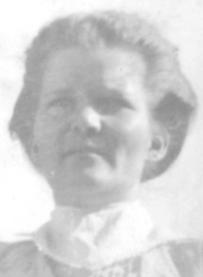 THE
ODYSSEY OF
THE
ODYSSEY OF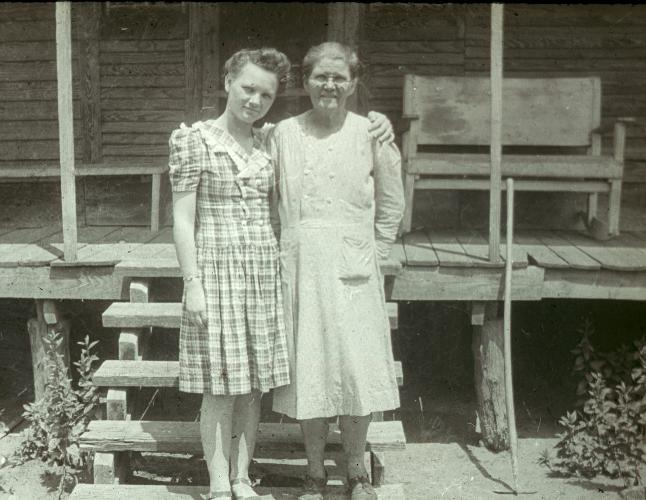 Josephine Moore was the daughter of James Morgan
Moore (b. MS 1849-1925) and Nancy Priscilla Touchstone (b. MS 1851-1934). Known as Josie
and the first born outside Mississippi during the odyssic wanderings of James and
Priscilla Moore, Josephine grew into womanhood after they settled in Miller County,
Arkansas near the Charles Coffner McKeehan family with children of similar ages.
Exactly how James Washington McKeehan and Josephine Moore met is unclear, but most agree
that his brother Braxton Bragg was the first to court her. They likely met after
James Washington returned home, or on visits to brother Braxton, after an abortive first
marriage when he became interested in the young Josephine and began to court her.
James Washington swept the 18 year old maiden off her feet. Soon after James
Washington and Josephine Moore McKeehan were married and produced a family of thirteen
children. Legend is that Braxton Bragg never married because he could never find another
equal to Josephine Moore that he had lost to brother James Washington. He remained a
close friend of the family, like a second father according to some James and Josie's
chidren, and lived nearby throughout his life.
Josephine Moore was the daughter of James Morgan
Moore (b. MS 1849-1925) and Nancy Priscilla Touchstone (b. MS 1851-1934). Known as Josie
and the first born outside Mississippi during the odyssic wanderings of James and
Priscilla Moore, Josephine grew into womanhood after they settled in Miller County,
Arkansas near the Charles Coffner McKeehan family with children of similar ages.
Exactly how James Washington McKeehan and Josephine Moore met is unclear, but most agree
that his brother Braxton Bragg was the first to court her. They likely met after
James Washington returned home, or on visits to brother Braxton, after an abortive first
marriage when he became interested in the young Josephine and began to court her.
James Washington swept the 18 year old maiden off her feet. Soon after James
Washington and Josephine Moore McKeehan were married and produced a family of thirteen
children. Legend is that Braxton Bragg never married because he could never find another
equal to Josephine Moore that he had lost to brother James Washington. He remained a
close friend of the family, like a second father according to some James and Josie's
chidren, and lived nearby throughout his life.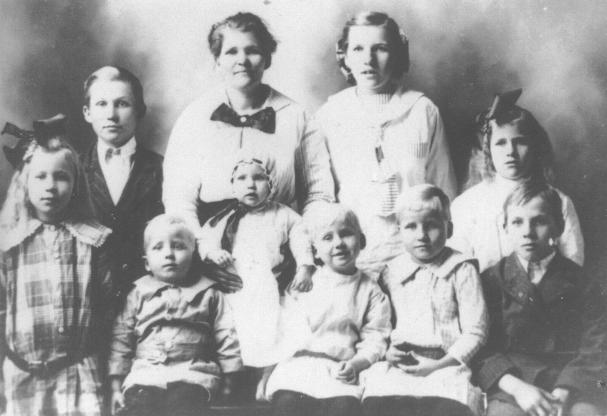
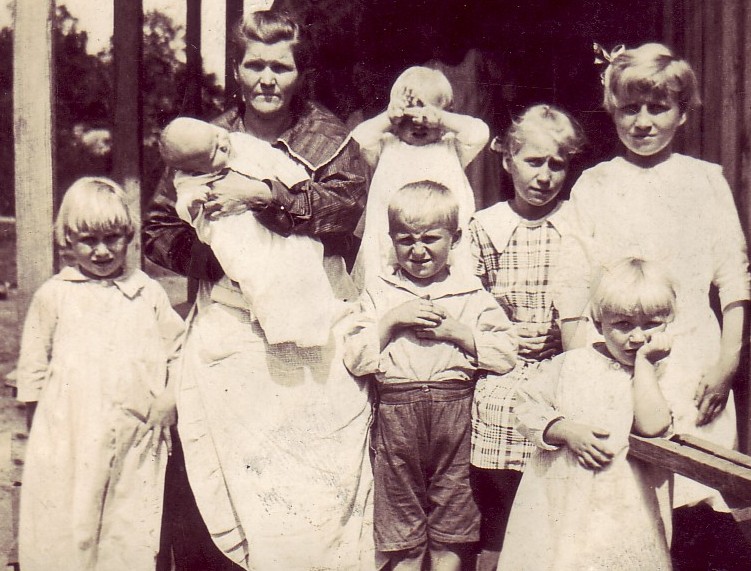 Surely
Mother McKeehan was one of those chosen in Him from before the foundation of the world
(Eph. 1:4). As a child, she was obedient, as a teenager she was virtuous, as a young lady
she maintained her integrity before the Lord. Josephine grew up in a home where the mother
and the father were split on the issues of religion. The father was Methodist and the
mother Baptist. This made Josephine uncertain as to what church was right. After Josephine
became betrothed to James W. McKeehan, she began to pray earnestly about the church matter
for her fiance was a Methodist man. While she was in one of these sessions of prayer, she
heard the voice of the Lord speaking thus "My Child, it does not make any difference,
just so that you come in My Name." She then joined the Methodist Church so that no
division be in their home as a result of religion.
Surely
Mother McKeehan was one of those chosen in Him from before the foundation of the world
(Eph. 1:4). As a child, she was obedient, as a teenager she was virtuous, as a young lady
she maintained her integrity before the Lord. Josephine grew up in a home where the mother
and the father were split on the issues of religion. The father was Methodist and the
mother Baptist. This made Josephine uncertain as to what church was right. After Josephine
became betrothed to James W. McKeehan, she began to pray earnestly about the church matter
for her fiance was a Methodist man. While she was in one of these sessions of prayer, she
heard the voice of the Lord speaking thus "My Child, it does not make any difference,
just so that you come in My Name." She then joined the Methodist Church so that no
division be in their home as a result of religion.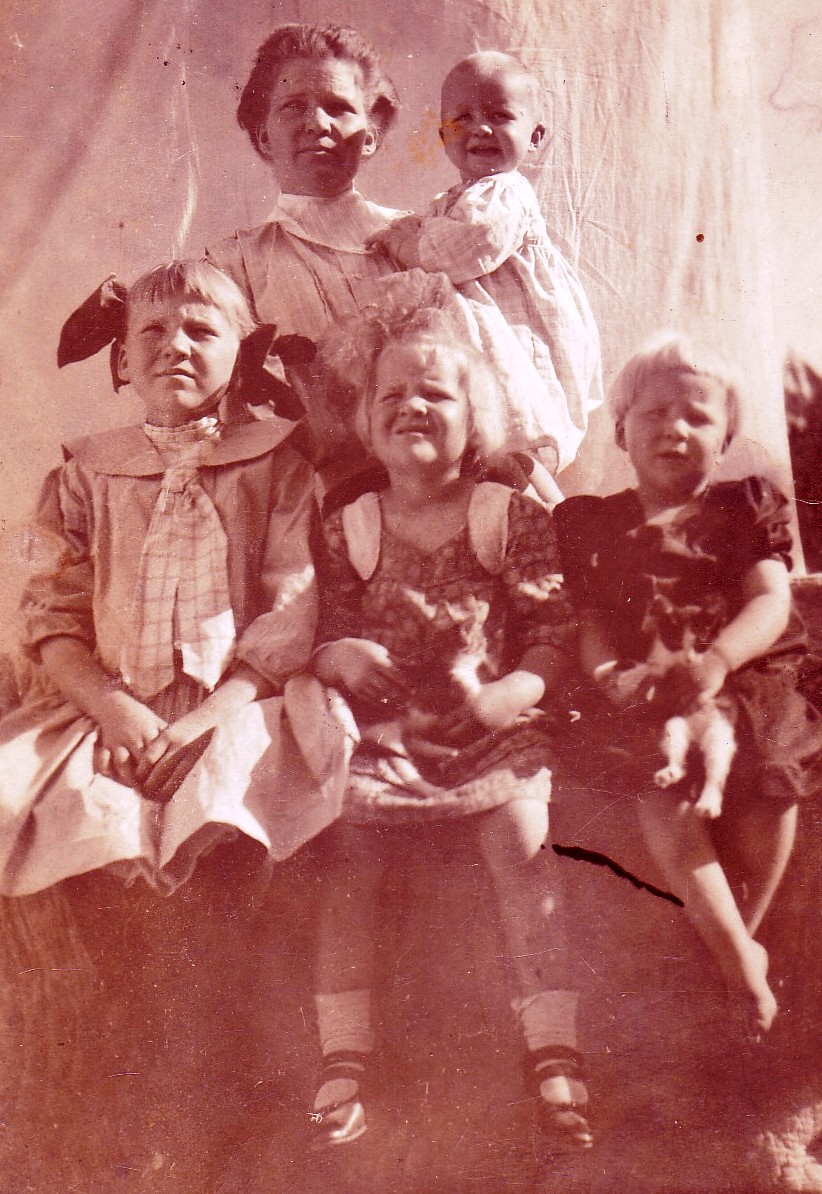 While the
younger ones were still at home, there came into the community a couple of Pentecostal
preachers holding small tent and brush arbor revivals. First an Assembly of God minister
under whose ministry my brother, Wallace McKeehan (b. 1913), came into the faith of the
Baptism of the Holy Ghost. Then a minister came baptizing in The Name of Jesus according
to Acts 2:38. He expounded the Word to my brother more fully and he was baptized in Jesus
Name. This brother was called to preach while he was plowing in the field. He saw a vision
of hell and people falling into it by the thousands. Then a voice told him to go warn
these people to flee the wrath to come. Another brother, Ray McKeehan [Ray Warren McKeehan
1904-1992], came home from the Navy, got into these revivals, repented of his sins. He was
baptized in Jesus Name, got the Holy Ghost and was called to preach. My, how he did study
his Bible. Then the brothers began to expound the work more fully, telling here where was
yet something more for her [Josephine Moore McKeehan]. Once again she began to pray and
reminded the Lord of what He had told here prior to joining the Methodist Church. She said
"Lord, I have followed you the best that I knew how. Have had to lean upon you
through it all and I have never brought any reproach on the church or your Name. They tell
there is something more, so now, I come to you for guidance again. Now what must I
do." That same sweet voice spoke to her and said "Come hither." Then she
humbled herself and was baptized in The Name of Jesus in a cow pasture where the
neighborhood children went swimming. Soon after this she was rubbing clothes on an old
fashioned rub board, meditating and washing away. Lo, she found herself speaking in a
language she never learned. She said "Lord, if this is that Holy Ghost, you must tell
me what I said." The voice said "Read Eph. 1:17." More and more the life of
Holiness shown forth from Mother McKeehan’s life. Always abounding in the strength of
the Lord.
While the
younger ones were still at home, there came into the community a couple of Pentecostal
preachers holding small tent and brush arbor revivals. First an Assembly of God minister
under whose ministry my brother, Wallace McKeehan (b. 1913), came into the faith of the
Baptism of the Holy Ghost. Then a minister came baptizing in The Name of Jesus according
to Acts 2:38. He expounded the Word to my brother more fully and he was baptized in Jesus
Name. This brother was called to preach while he was plowing in the field. He saw a vision
of hell and people falling into it by the thousands. Then a voice told him to go warn
these people to flee the wrath to come. Another brother, Ray McKeehan [Ray Warren McKeehan
1904-1992], came home from the Navy, got into these revivals, repented of his sins. He was
baptized in Jesus Name, got the Holy Ghost and was called to preach. My, how he did study
his Bible. Then the brothers began to expound the work more fully, telling here where was
yet something more for her [Josephine Moore McKeehan]. Once again she began to pray and
reminded the Lord of what He had told here prior to joining the Methodist Church. She said
"Lord, I have followed you the best that I knew how. Have had to lean upon you
through it all and I have never brought any reproach on the church or your Name. They tell
there is something more, so now, I come to you for guidance again. Now what must I
do." That same sweet voice spoke to her and said "Come hither." Then she
humbled herself and was baptized in The Name of Jesus in a cow pasture where the
neighborhood children went swimming. Soon after this she was rubbing clothes on an old
fashioned rub board, meditating and washing away. Lo, she found herself speaking in a
language she never learned. She said "Lord, if this is that Holy Ghost, you must tell
me what I said." The voice said "Read Eph. 1:17." More and more the life of
Holiness shown forth from Mother McKeehan’s life. Always abounding in the strength of
the Lord.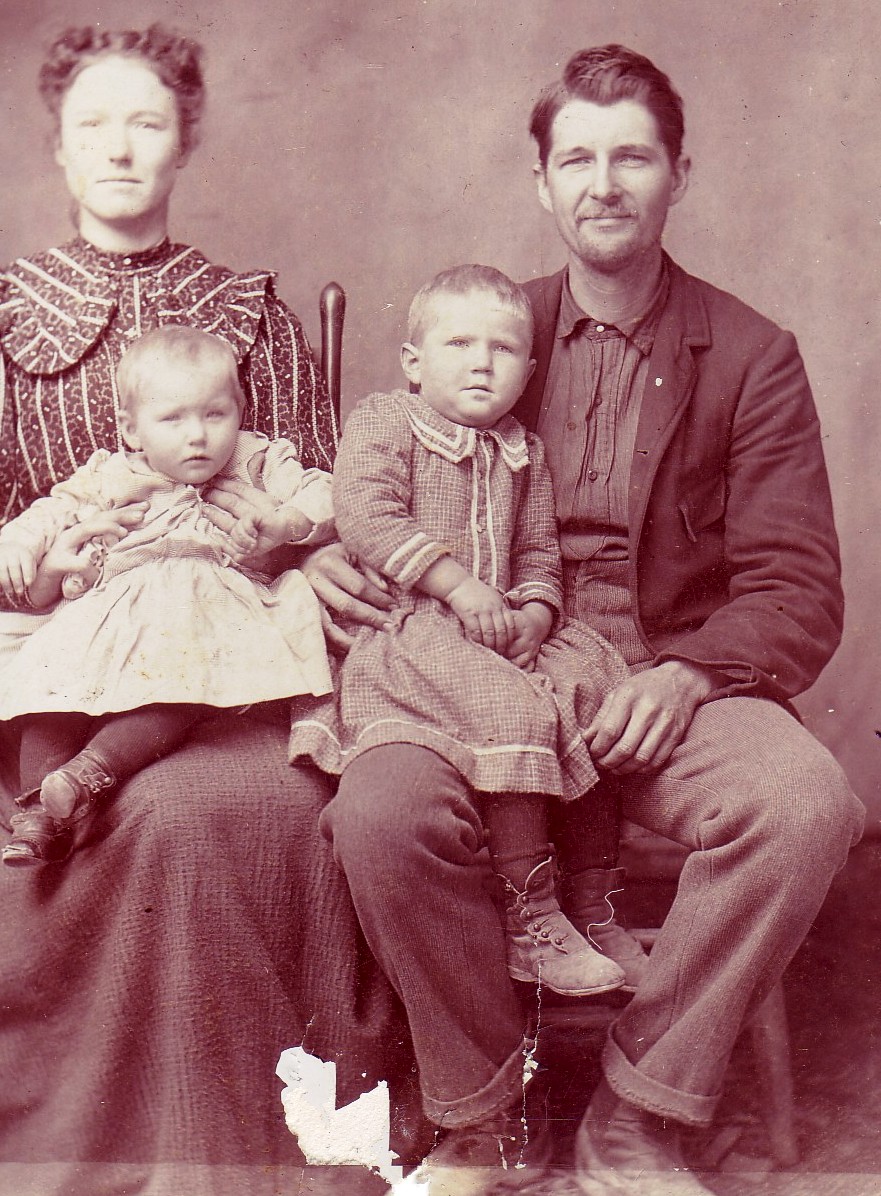
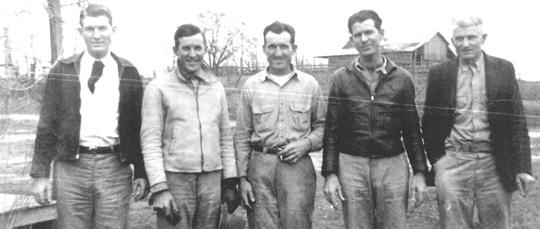
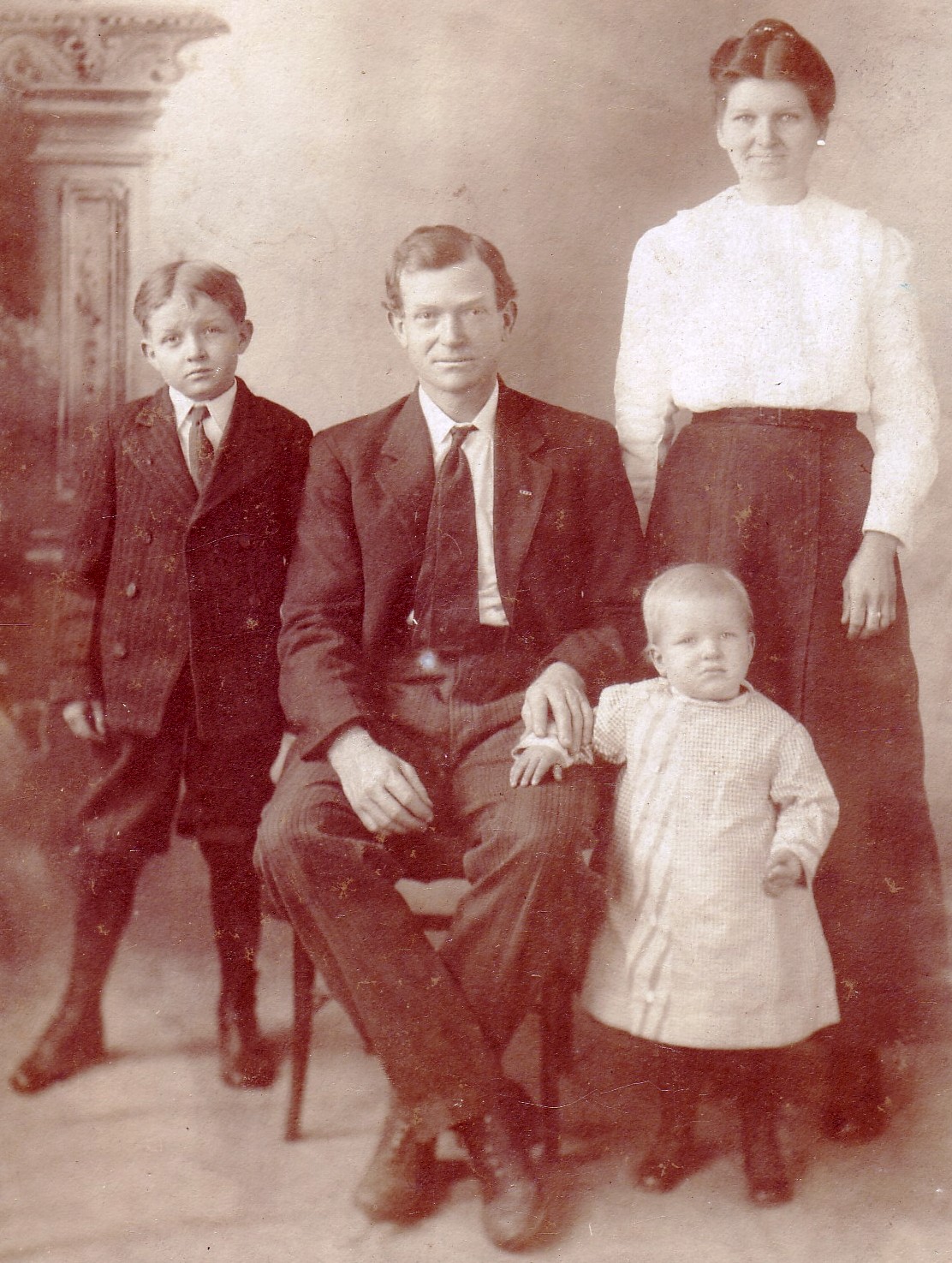
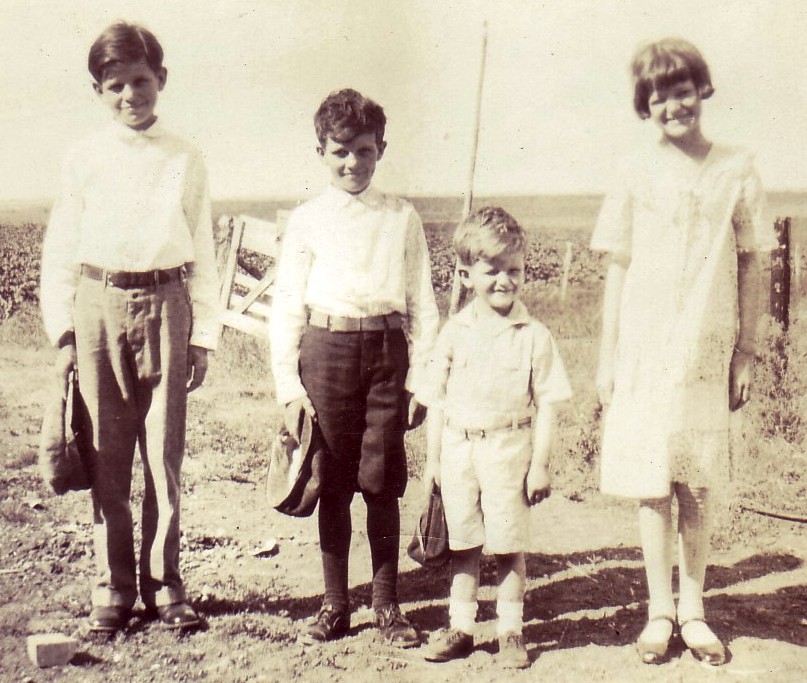
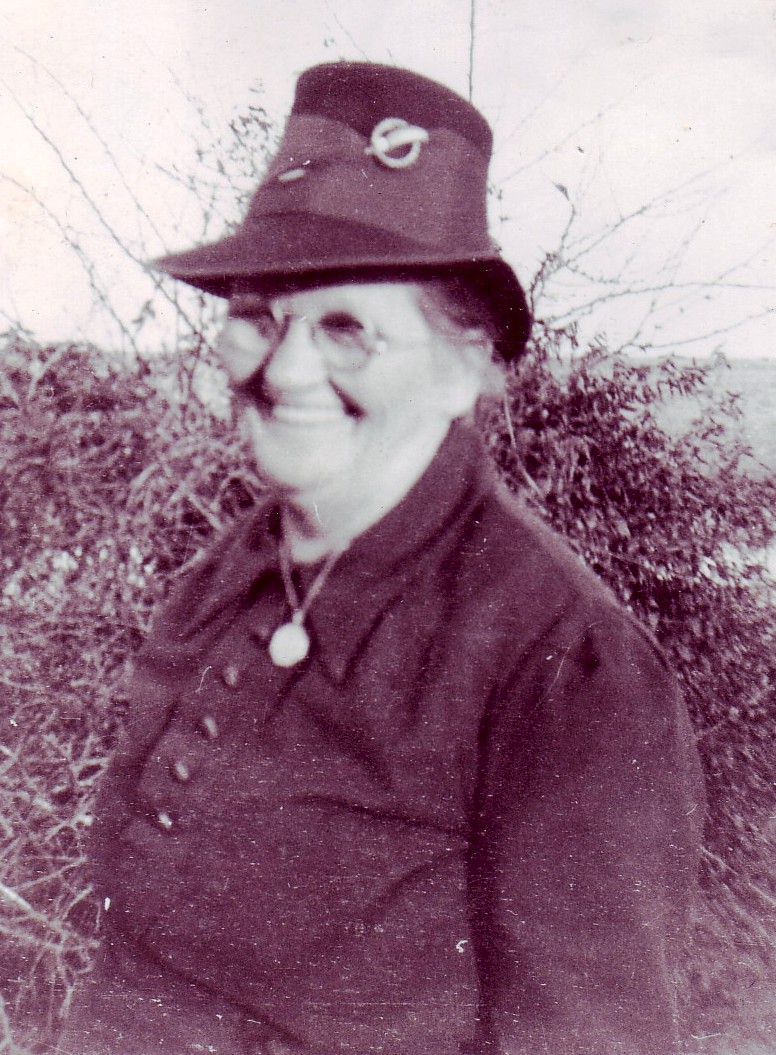
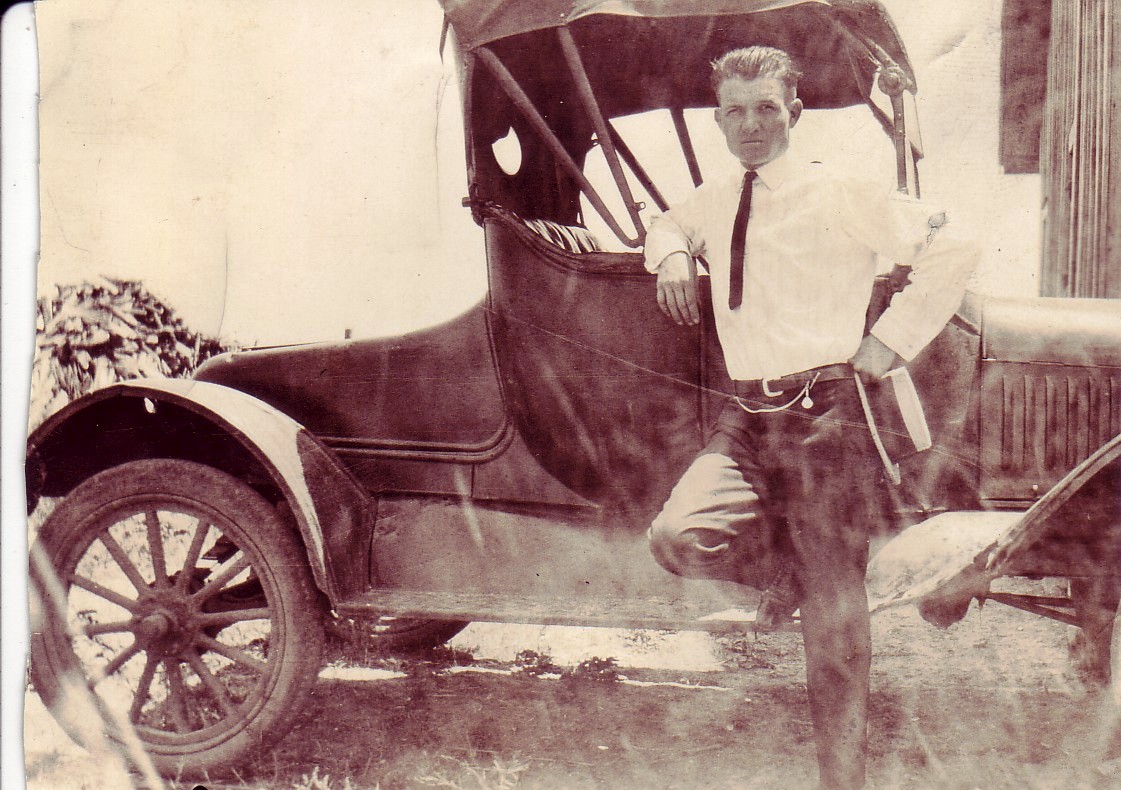
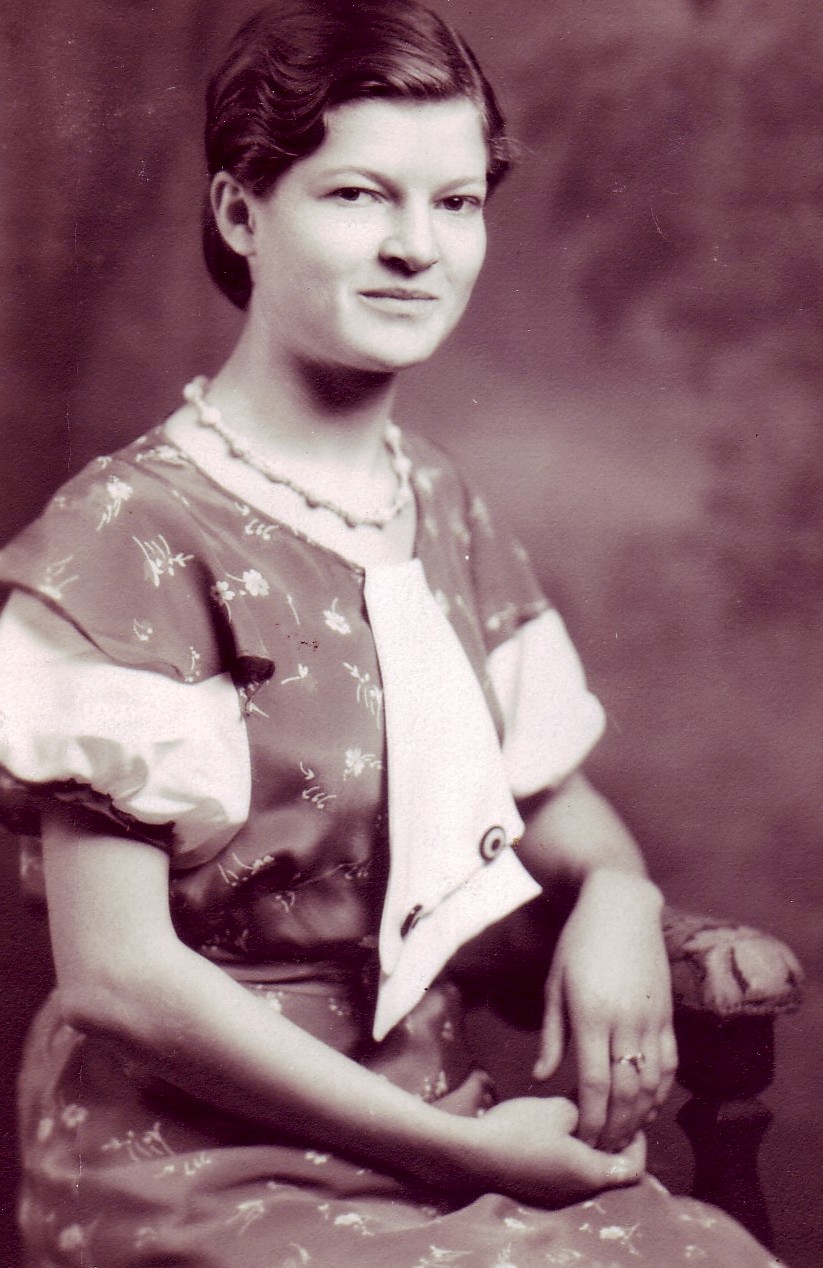
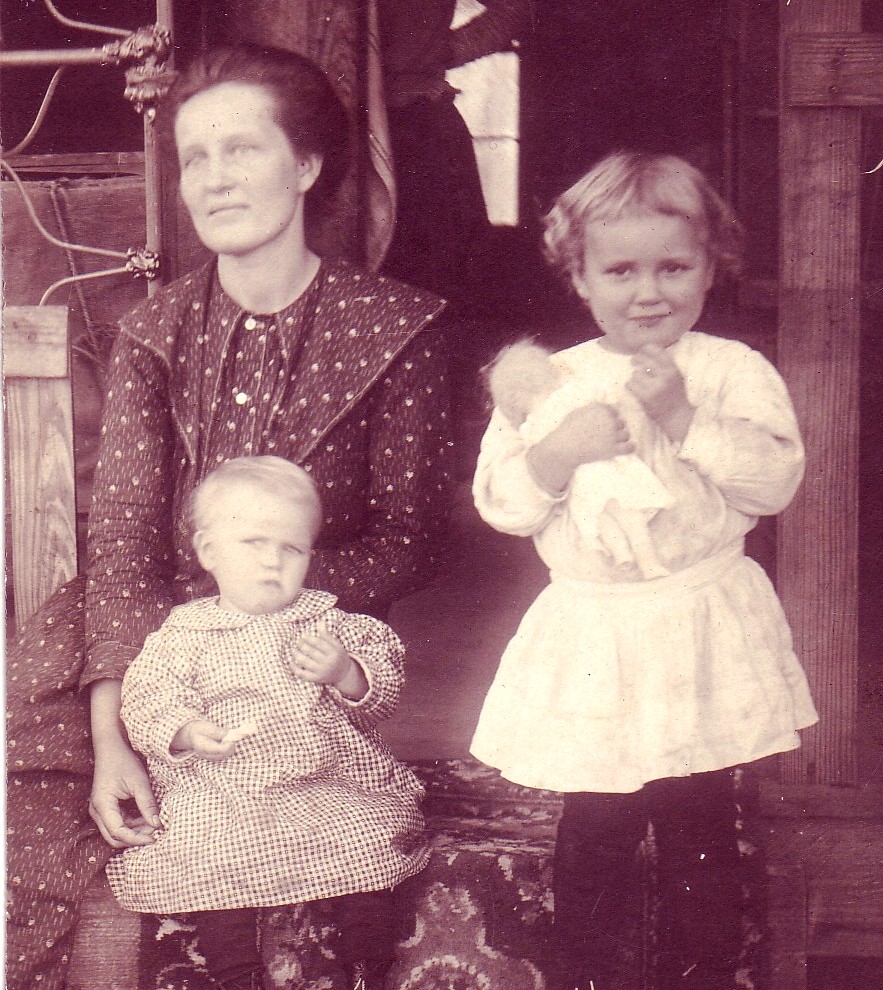
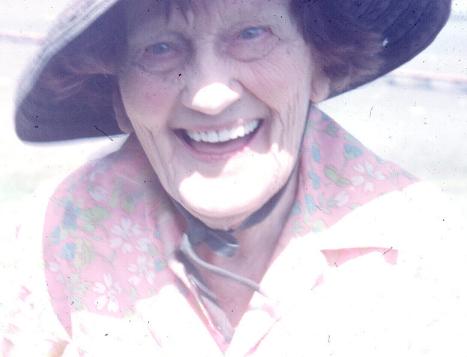 Recorded
stories from Pauline Moore Fricks. The following two tracks were recorded when
Pauline was 91 years old in 1975 by her daughter May at the request of W.C.
McKeehan.
Recorded
stories from Pauline Moore Fricks. The following two tracks were recorded when
Pauline was 91 years old in 1975 by her daughter May at the request of W.C.
McKeehan. 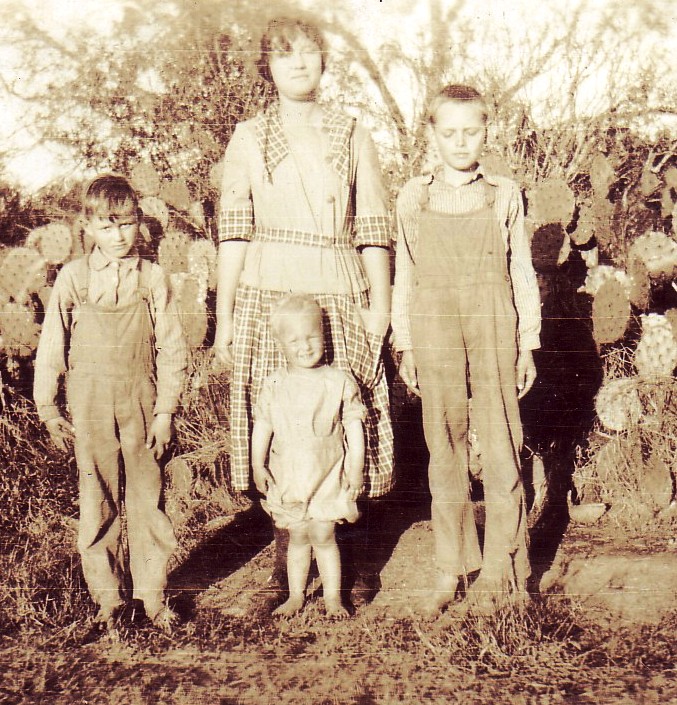 Back home
in Arkansas, he married and his wife (name unknown) died at an early age. Before the death
of his wife, the couple had three sons, Billy, M.D. and John, and a daughter, Melinda. The
Fricks family was originally from Germany and the original spelling was believed to be
Frick or Frix. M.D. Fricks married Pauline Moore whose parents were Priscilla Touchstone
and James Moore. Miss Moore’s ancestors were Irish and English, some of them came to
America on the Mayflower. Priscilla Moore and husband James lived in the Ozark
Mountains of Arkansas. They had seven girls and three boys. Pauline was born 17 August
1884 and she married M.D. Fricks in 1903. They had five children, May, Ewel, Ethan, Gee
and Bill. M.D. Fricks had a meat market in Texarkana for several years. Ewel died at the
age of two. The M.D. Fricks family moved to Refugio County, Texas in 1913. M.D. and a
brother chartered a boxcar for the livestock and household belongings. M.D. rode with the
boxcar and the rest of the family came by passenger train to Woodsboro, Texas. When they
first arrived in Woodsboro, they were greeted by a cold norther and driving rain. The two
families stayed in the Warren Hotel until they rented land with a house on it. Arriving on
the farm, Mr. Walter Barber immediately introduced them to the south Texas regional food
with a bunch of raw fresh oysters in the shell just picked up in the nearby bays. Without
extensive washing, the family carefully shucked them preserving all the liquid to cook
them in. The resulting dish was very salty and gritty, but no one suffered and everyone
got their hunger satisfied. Mrs. Fricks, May and Ethan attended the first funeral in La
Rosa Cemetery [unclear if this refers to a relative or just general experience] .
Back home
in Arkansas, he married and his wife (name unknown) died at an early age. Before the death
of his wife, the couple had three sons, Billy, M.D. and John, and a daughter, Melinda. The
Fricks family was originally from Germany and the original spelling was believed to be
Frick or Frix. M.D. Fricks married Pauline Moore whose parents were Priscilla Touchstone
and James Moore. Miss Moore’s ancestors were Irish and English, some of them came to
America on the Mayflower. Priscilla Moore and husband James lived in the Ozark
Mountains of Arkansas. They had seven girls and three boys. Pauline was born 17 August
1884 and she married M.D. Fricks in 1903. They had five children, May, Ewel, Ethan, Gee
and Bill. M.D. Fricks had a meat market in Texarkana for several years. Ewel died at the
age of two. The M.D. Fricks family moved to Refugio County, Texas in 1913. M.D. and a
brother chartered a boxcar for the livestock and household belongings. M.D. rode with the
boxcar and the rest of the family came by passenger train to Woodsboro, Texas. When they
first arrived in Woodsboro, they were greeted by a cold norther and driving rain. The two
families stayed in the Warren Hotel until they rented land with a house on it. Arriving on
the farm, Mr. Walter Barber immediately introduced them to the south Texas regional food
with a bunch of raw fresh oysters in the shell just picked up in the nearby bays. Without
extensive washing, the family carefully shucked them preserving all the liquid to cook
them in. The resulting dish was very salty and gritty, but no one suffered and everyone
got their hunger satisfied. Mrs. Fricks, May and Ethan attended the first funeral in La
Rosa Cemetery [unclear if this refers to a relative or just general experience] .
